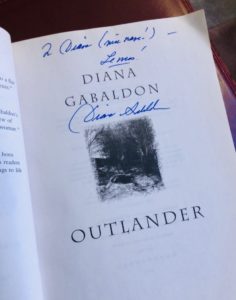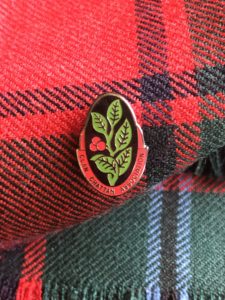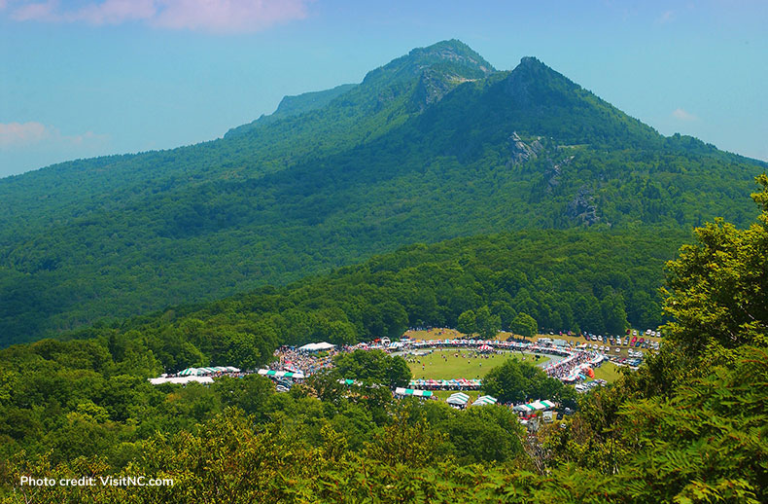This weekend is the Grandfather Mountain Highland Games in the Blue Ridge Mountains of western North Carolina. It’s a bucket list event for many Scots-Irish and Scottish Americans. Though not the oldest or largest of games in the United States, it is special because of its location and connection to the history of Scottish Americans and Scots-Irish who were the early settlers of what was considered the western frontier in the mid-to-late 1700s of colonial America. Started in 1956, it is held the second weekend in July at MacRae Meadows at the base of Grandfather Mountain. For me it will be a diversion to explore my Scots-Irish roots in western North Carolina and to meet extended family who have been found on the road to discovering my Scottish ancestry.
Outlander Diversions at GMHG

This will be my second time to attend the Grandfather Mountain Highland Games (GMHG); the first was in 2008 when I had the opportunity to meet the author Diana Gabaldon and have her sign my copy of Outlander. This was apparently her first time to visit the area where she had set Jamie and Claire Fraser’’s home in the New World. In a blog post about the visit, she wrote that after two days of research in the area, she had decided that Fraser’s Ridge was about 10 miles from Blowing Rock, NC!
While my second visit to the GMHG, it will be the first since learning that my Scots-Irish ancestor Arthur McFalls was one of the pioneer settlers of the area. Arthur, my fifth great-grandfather, followed the Great Wagon Road along with many Scots-Irish immigrants from Virginia, where he was born in 1750, to the Blue Ridge Mountains of western North Carolina. We think that his father, John McFalls, immigrated with relatives from Northern Ireland in the 1740s perhaps as part of the movement from the Scottish lowlands to the Ulster plantations in Northern Ireland in the late 1600s and early 1700s.
American McFalls to Scottish MacPhails
My mother and I have been working to establish the ancestral connection from our American McFalls to Scottish MacPhails. Since I first wrote about Arthur in February 2020, my mother has connected with descendants from seven of Arthur’s 10 children (with three different women). To help unravel the question of which descendants went with which wife, we started an Arthur McFalls ancestry group on Facebook; the group currently has 93 members, most of whom are descendants of Arthur though some are likely descended from siblings or cousins of Arthur.
Autosomal DNA testing of multiple McFalls family members (male and female) through Ancestry.com provided enough information for us to gather descendants of Arthur here in the United States (including one in Colorado!), but we were not able to take Arthur’s ancestry “across the pond” until a male relative agreed to a Y-DNA test. We needed a tool that would provide information beyond the seven generations we had established in the United States.
A Y-DNA test looks at the male-inherited Y chromosome DNA. Since there’s little or no alteration in the Y chromosome transfer chain from father to son, the Y DNA test enables males to trace their genealogy through their paternal line — in our case the paternal McFalls line — often providing info on DNA connections in the eighth through 12th generations.

Y-DNA helps connect to Scottish Ancestry
Our male relative first did the FamilyTree Y-DNA37 test, and then upgraded to the Y67. He recently joined the Clan Chattan DNA project on FamilyTree DNA (MacPhails are one of the 12 clans in this unique confederation of Highland clans). The administrators of the project have recommended he do additional testing that will help narrow geographical origins. Since making the connection to Scotland is our goal, we are considering the various options; though some, such as the Big Y test, can cost up to $500.
Through the Y-DNA testing and joining the Clan Chattan DNA project, we’ve discovered several “cousins” with Scottish or Ulster roots. One Scottish cousin, to whom we connect within the last eight to 12 generations, has traced his McFall/s ancestry to northern Ireland and County Antrim – so from Scotland to Ulster back to Scotland. We also have found two other cousins through Y-DNA testing who have McFall ancestors who were born in or immigrated from County Antrim in Northern Ireland to the American colonies.
While the DNA testing has been a tremendous help in discovering the roots of the McFalls ancestry, we have relied on history to provide confirmation. Knowing that there was a huge wave of Scots-Irish who came from Northern Ireland and the Ulster plantations to the American colonies in the late 1600s through the late 1700s helped my mother and I understand that we must first go through Northern Ireland to get back to Scotland. As much as I wish that my Scottish ancestry was more straightforward — how about three or four generations back instead of eight to 12! — that is not the history of most of the descendants of the Scots-Irish settlers in the mountains of western North Carolina and eastern Tennessee.
Diversions to meet new family
As we make incremental progress in getting back to Scotland, I look forward to meeting several of my western North Carolina cousins who are Arthur McFalls descendants at the Grandfather Mountain Highland Games. Who knows what common traits we may discover that we’ve inherited from “old Arter”?! And even though we are still unsure of where and when Arthur’s ancestors lived in Scotland, perhaps we will still share a wee dram in honor of the McFalls/MacPhails who brought us together!


